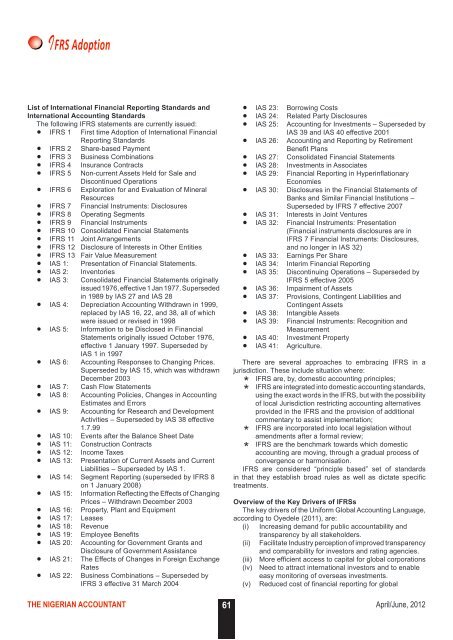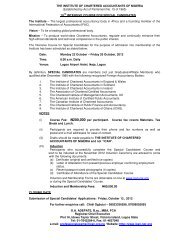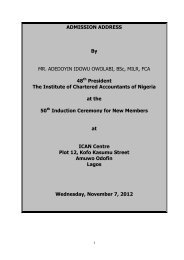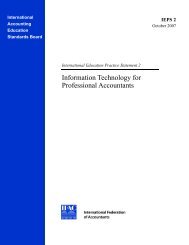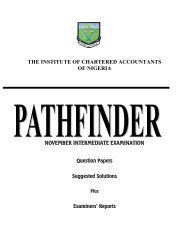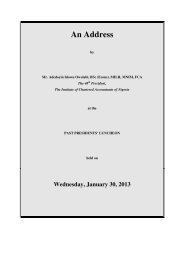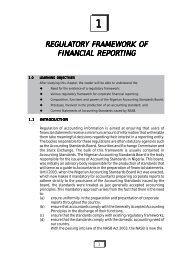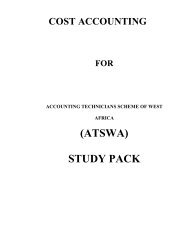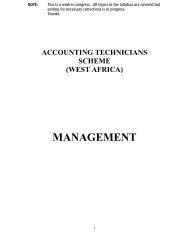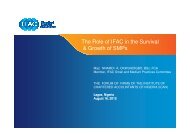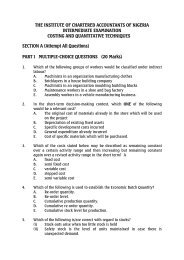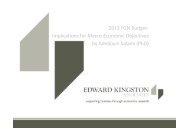The Nigerian Accountant 2012 - The Institute of Chartered ...
The Nigerian Accountant 2012 - The Institute of Chartered ...
The Nigerian Accountant 2012 - The Institute of Chartered ...
You also want an ePaper? Increase the reach of your titles
YUMPU automatically turns print PDFs into web optimized ePapers that Google loves.
IFRS Adoption<br />
List <strong>of</strong> International Financial Reporting Standards and<br />
International Accounting Standards<br />
<strong>The</strong> following IFRS statements are currently issued:<br />
• IFRS 1 First time Adoption <strong>of</strong> International Financial<br />
Reporting Standards<br />
IFRS 2 Share-based Payment<br />
IFRS 3 Business Combinations<br />
IFRS 4 Insurance Contracts<br />
• IFRS 5 Non-current Assets Held for Sale and<br />
Discontinued Operations<br />
• IFRS 6 Exploration for and Evaluation <strong>of</strong> Mineral<br />
Resources<br />
IFRS 7 Financial Instruments: Disclosures<br />
IFRS 8 Operating Segments<br />
IFRS 9 Financial Instruments<br />
IFRS 10 Consolidated Financial Statements<br />
IFRS 11 Joint Arrangements<br />
IFRS 12 Disclosure <strong>of</strong> Interests in Other Entities<br />
IFRS 13 Fair Value Measurement<br />
IAS 1: Presentation <strong>of</strong> Financial Statements.<br />
IAS 2: Inventories<br />
•<br />
•<br />
•<br />
•<br />
IAS 3: Consolidated Financial Statements originally<br />
issued 1976, effective 1 Jan 1977. Superseded<br />
in 1989 by IAS 27 and IAS 28<br />
IAS 4: Depreciation Accounting Withdrawn in 1999,<br />
replaced by IAS 16, 22, and 38, all <strong>of</strong> which<br />
were issued or revised in 1998<br />
IAS 5: Information to be Disclosed in Financial<br />
Statements originally issued October 1976,<br />
effective 1 January 1997. Superseded by<br />
IAS 1 in 1997<br />
IAS 6: Accounting Responses to Changing Prices.<br />
Superseded by IAS 15, which was withdrawn<br />
December 2003<br />
IAS 7: Cash Flow Statements<br />
•<br />
Estimates and Errors<br />
•<br />
IAS 8: Accounting Policies, Changes in Accounting<br />
IAS 9: Accounting for Research and Development<br />
Activities – Superseded by IAS 38 effective<br />
1.7.99<br />
IAS 10: Events after the Balance Sheet Date<br />
IAS 11: Construction Contracts<br />
IAS 12: Income Taxes<br />
•<br />
Liabilities – Superseded by IAS 1.<br />
•<br />
on 1 January 2008)<br />
•<br />
Prices – Withdrawn December 2003<br />
IAS 16: Property, Plant and Equipment<br />
IAS 17: Leases<br />
IAS 18: Revenue<br />
IAS 19: Employee Benefits<br />
•<br />
•<br />
Rates<br />
•<br />
IAS 13: Presentation <strong>of</strong> Current Assets and Current<br />
IAS 14: Segment Reporting (superseded by IFRS 8<br />
IAS 15: Information Reflecting the Effects <strong>of</strong> Changing<br />
IAS 20: Accounting for Government Grants and<br />
Disclosure <strong>of</strong> Government Assistance<br />
IAS 21: <strong>The</strong> Effects <strong>of</strong> Changes in Foreign Exchange<br />
IAS 22: Business Combinations – Superseded by<br />
IFRS 3 effective 31 March 2004<br />
IAS 23: Borrowing Costs<br />
•<br />
•<br />
Benefit Plans<br />
•<br />
Economies<br />
•<br />
IAS 24: Related Party Disclosures<br />
IAS 25: Accounting for Investments – Superseded by<br />
IAS 39 and IAS 40 effective 2001<br />
IAS 26: Accounting and Reporting by Retirement<br />
IAS 27: Consolidated Financial Statements<br />
IAS 28: Investments in Associates<br />
IAS 29: Financial Reporting in Hyperinflationary<br />
IAS 30: Disclosures in the Financial Statements <strong>of</strong><br />
Banks and Similar Financial Institutions –<br />
Superseded by IFRS 7 effective 2007<br />
IAS 31: Interests in Joint Ventures<br />
•<br />
IAS 32: Financial Instruments: Presentation<br />
(Financial instruments disclosures are in<br />
IFRS 7 Financial Instruments: Disclosures,<br />
and no longer in IAS 32)<br />
IAS 33: Earnings Per Share<br />
• •<br />
Contingent Assets<br />
IAS 38: Intangible Assets<br />
•<br />
Measurement<br />
• IAS 41: Agriculture.<br />
IAS 34: Interim Financial Reporting<br />
IAS 35: Discontinuing Operations – Superseded by<br />
IFRS 5 effective 2005<br />
IAS 36: Impairment <strong>of</strong> Assets<br />
IAS 37: Provisions, Contingent Liabilities and<br />
IAS 39: Financial Instruments: Recognition and<br />
IAS 40: Investment Property<br />
<strong>The</strong>re are several approaches to embracing IFRS in a<br />
jurisdiction. <strong>The</strong>se include situation where:<br />
IFRS are, by, domestic accounting principles;<br />
IFRS are integrated into domestic accounting standards,<br />
*<br />
using the exact words in the IFRS, but with the possibility<br />
<strong>of</strong> local Jurisdiction restricting accounting alternatives<br />
provided in the IFRS and the provision <strong>of</strong> additional<br />
commentary to assist implementation;<br />
IFRS are incorporated into local legislation without<br />
*<br />
amendments after a formal review;<br />
IFRS are the benchmark towards which domestic<br />
*<br />
accounting are moving, through a gradual process <strong>of</strong><br />
convergence or harmonisation.<br />
IFRS are considered “principle based” set <strong>of</strong> standards<br />
in that they establish broad rules as well as dictate specific<br />
treatments.<br />
Overview <strong>of</strong> the Key Drivers <strong>of</strong> IFRSs<br />
<strong>The</strong> key drivers <strong>of</strong> the Uniform Global Accounting Language,<br />
according to Oyedele (2011), are:<br />
(i) Increasing demand for public accountability and<br />
transparency by all stakeholders.<br />
(ii) Facilitate Industry perception <strong>of</strong> improved transparency<br />
and comparability for investors and rating agencies.<br />
(iii) More efficient access to capital for global corporations<br />
(iv) Need to attract international investors and to enable<br />
easy monitoring <strong>of</strong> overseas investments.<br />
(v) Reduced cost <strong>of</strong> financial reporting for global<br />
THE NIGERIAN ACCOUNTANT 61<br />
April/June, <strong>2012</strong>


